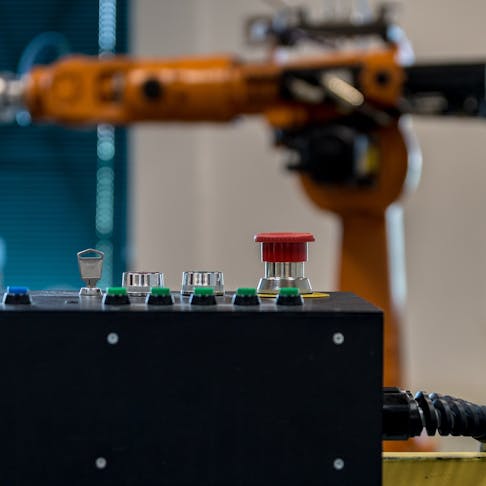Many machine shops are turning to automation as a way to improve efficiency and productivity while reducing costs. Automation can help maximize production output, reduce machine downtime, and improve shop safety. As manufacturing businesses continue to evolve, machine shop automation is becoming increasingly important. A manufacturer must take the necessary steps to ensure that mechanization is implemented correctly and efficiently.
Even shops with limited resources can benefit from automation. Each of the many modern automation techniques is suited to different manufacturing strategies and differs based on production scale and cost.
They all benefit from several generalized tips and tricks manufacturers can follow to ensure that the transition is successful. In this article, we will discuss what machine shop automation means, its importance, and tips on how to automate your operation.
What Is Machine Shop Automation?
Machine shop automation is the process of introducing automated operations into a production floor. Automation can mean replacing manual processes with machine-operated processes or replacing operations with computer-controlled equipment. Many shops add robotic arms and automated tools to perform operations while also integrating machine learning and computer vision systems into the whole production process. Along the way, it’s often necessary to program tools for automatic equipment operation.
Importance of Automating Your Shop
Automating your shop can have many benefits. It can help improve accuracy and consistency in your output; machines can perform identical movements many times over whereas a human operator would be slightly inconsistent. Automation can reduce downtime, minimize labor costs, and allow shops to operate faster and more efficiently. It can also reduce safety risks since machine operations are handled by tools instead of operators.
Collectively, all these advantages improve production output because automated processes are handled much more quickly and with greater precision than manual processes.
Tips on How to Start Automation in Machine Shops
Listed below are some tips to automate your shop floors:
- Assess Production Needs: Before introducing automation, shop owners should assess their production floor’s needs and their current processes to determine which activity would benefit most from automation. This assessment should help shop owners and team leaders decide which machine operations are best suited for computerized replacements and what tools would best fit the production’s needs. Also, this will help you identify repetitive processes such as cutting and drilling that are best left to automated machines.
Because part production needs assessment, machine shops should also automate the quoting process. It should improve turnaround times. An effective quoting program can deduce prices using data such as markups, inventory expenses, and hourly rates. - Choose Appropriate Tools: Once you have identified your production needs, it is time to choose machine tools that suit your processes. Some factors to consider are: cost, the impact on other processes, manpower, and availability of training for the operators who will handle them. If you don’t personally have a thorough understanding of these tools, find someone who does so they can accurately determine which will fit your requirements. Some common machine tools include: milling machines, drill presses, welding machines, inspection equipment, and metal lathe machines.
- Develop Machine Programming: After choosing the appropriate tools, shop owners need to look at the development of machine programming. Machine programming is a field of study focused on the use of computers and automation to create products such as tools, parts, and fixtures through automated instruction codes. The goal of machine programming is to optimize operations for successful automation in the shop. There are a few simple steps that can help you achieve this goal.
First, it is important to understand the capabilities and limitations of the equipment you work with. This allows you to create programs that are both effective and efficient. Second, focus on building flexibility in your programs so they can be adapted as needed. This will help you avoid costly downtime and disruptions in production. Finally, keep your programs well organized and documented. Such organization will make it easier to troubleshoot any issues that arise and will also help you train new employees on the system. - Train Machine Operators: Before any upgrade is implemented, all operators and key personnel need the proper training. Training should focus on programming and operational safety. The process will help the operators better understand the new equipment and processes.
- Implementation: After programming and operator training is complete, implementation comes next. Shop owners and floor leaders should closely monitor production and operation accuracy to ensure that no problems will arise. This is a crucial time to check process compatibility and assess whether your team needs additional tools or knowledge.
- Review Production Performance: Machine shops should regularly review their production and operation accuracy to ensure the automation is meeting shop needs. This machine shop review should include tool maintenance and programming oversight. If the automated process is not meeting the shop's needs, programming or tool maintenance should be adjusted as necessary.
Machine shop tracking should account for equipment operation accuracy and downtime to ensure it is running efficiently. Many shops use machine tracking software to track production and tool maintenance. This tracking software can provide owners with analytics to help them understand production and tool maintenance so they can improve upon the automated processes even further. - Monitor Machine Tool Maintenance: Regular monitoring of tool maintenance is necessary to keep automation tools running efficiently and accurately. This means developing and following through on a preventive maintenance schedule and repair procedures. Employees should monitor tool maintenance so they can identify potential production issues and maintenance problems before they impact operations.
Choosing the Best Automation Technology for Your Manufacturing Shop
By following these machine shop automation tips, manufacturers can successfully automate production operations. Numerous automation technologies are available today, including: shapers, additive manufacturing (3D printers), lathes, robotics, planers, and grinding machines. A thorough understanding of these technologies will help you decide which is best suited for your machine shop’s needs.

